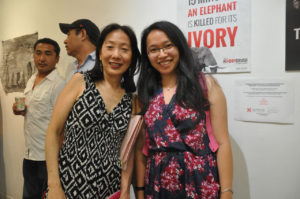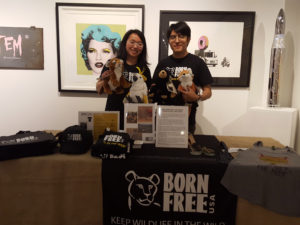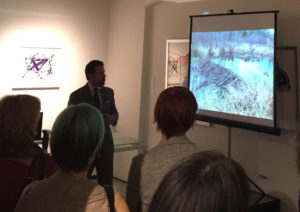Environmental Justice: Art and Protecting Wildlife
By Yichun Luo
In 2008, I started my academic experience at John Jay College. While exploring the study of justice, I found myself also becoming interested in visual art. My first studio art class was Introduction to Drawing taught by Professor Mary Ting. I continued to take more art classes and completed an art minor for my undergraduate study in International Criminal Justice. I kept in touch with Professor Ting and years later she has led me back to environmental justice through the art she first inspired me to study.
I am interested in Professor Ting’s ongoing project on wildlife trafficking, “Compassion: For the Animals Great & Small,” in which she raises public awareness about the elephants, rhinos, tigers, bears and other animals on the brink of extinction due to international consumer demand for wildlife products, particularly in China.

Through her art exhibition and series of public programs, she discusses the terrors of the illegal ivory trade, the cruelty of the bear bile industry and other forms of endangered animal luxury products. Prof. Ting’s project focuses on endangered elephants from the illegal ivory trades, discloses the plight of jeopardized bears from the bear bile industry, and raises public awareness of the need for animal protection.
There are many widely believed misconceptions about the illegal ivory trade, which Prof. Ting’s work seeks to correct. Some people mistakenly think elephants can still live without their ivory tusks, and many people are also unaware that many terrorist groups get budgets from ivory smuggling. Prof. Ting talks about how the United States is the second largest market for illegal ivory, next to China. Despite this very active market for ivory in the U.S., there is a lack of common knowledge that the ivory trade not only kills elephants, but also benefits illegal funds.
Particularly in China, the bear bile industry is a horrible market economy. Prof. Ting introduced me to Martin Guinness’ film Cages of Shame which documents a bear-rescuing expedition in mainland China. Bear bile is a part of traditional Chinese medicine, in which liquor made from bear bile is believed to help people grow stronger or cure their pain.
Personally, I heard about bear gallbladder during my childhood in China, but I had not learned about the bear bile industry where bile is extracted from a live bear. Growing up in the Chinese countryside, I learned that bears are beasts of prey and the bear gallbladder can mystically make a person stronger and braver. Bears have been depicted as the most ferocious and violent animal, but they cannot live without their gallbladders; because of this, bear gallbladders are thought to be valuable. I was shocked when I was watching the documentary. I found myself feeling guilty for not being aware of this problem in my motherland, as I was too young to discover this fact. The development of modern technology has accelerated the bear bile industry’s extracting of from live bears again and again. On the top of killing bears, the extraction results in torturing the bears for their entire lives.
Looking back, I wish had gotten more involved with the field of wildlife conservation during my graduate study in Public Administration. Fortunately, I have learned about these facts now. Although I am just one of the passionate people who cares about animals, I have made progress in utilizing my study to make a little difference in society. I have posted some of the WILDAID public service announcements that I first discovered at the COMPASSION exhibition on my Chinese chat site to raise awareness among my old classmates. Dramatically, some of my old classmates were posting online sales for dry manta rays and shark fins imported from Southeast Asia. The violence against animals is spreading all over the world, especially in places where people only value the animal products, but ignore the violent facts of animals dying.
Due to a growing awareness of environmental justice, I have come to care more about animal protection. In recent months, I have been volunteering with Born Free USA, a national animal advocacy nonprofit organization, together with other John Jay students, alumni, and Professor Ting. We are all working to end the exotic pet trade. I am working on a data collection project, which documents exotic pet ads posted on a classified ad site that offers animal sales. Each of us is given a different website to document individual exotic animal advertisements and indicate on a data list the type of animal. I check the advertisements to see where the ad is from, how many animals are for sale, and whether the seller provides sufficient information regarding the age, health, welfare concerns and other care related aspects.
I also volunteered in Born Free USA’s “2016 Art of Wildlife Conservation” event on May 5, 2016 at Taglialatella Galleries in New York City, where I met people with varying backgrounds but with one dream of protecting animals.

People who are concerned about animal protection come together for an auction to raise money for Born Free. On the day the Taglialatella Gallery was giving twenty percent of any sales of the artwork to Born Free USA. This is a significant gift, as this gallery has artwork by very famous artists such as Andy Warhol and Keith Haring with high price tags.
Adam M. Roberts is the CEO of Born Free USA, and has spent over 25 years working for animal protection. He gave a presentation of their programs, such as the 2016 The Year of the Lion, the Primate Sanctuary, Ethiopian rescue center, and the campaigns against trapping and the international wildlife trade. He explained the organization’s connection to the 1984 film Born Free and its mission to keep “wildlife in the wild.”

Among all this large scale information, I was particularly horrified by a part of the presentation that showed a bird in a national park caught in a trap which forced the bird’s head under the water, unable to breathe. This scene would be too ruthless to imagine, but its reality has been imprinted on my mind.
From this volunteer experience, I am inspired to make my own efforts to protect wildlife. I wish to contribute my knowledge and experience to take part in environmental protection, starting from my community. Environmental justice is not one person’s duty, but requires public awareness to hold accountability which should form in common knowledge.
For further information: